Advanced Managerial Finance: Axis Corp. Project Selection, MBA 712
VerifiedAdded on 2022/08/15
|9
|1382
|19
Case Study
AI Summary
This case study analyzes two potential investment projects for Axis Corporation, a company looking to expand its business by manufacturing new spares for motor vehicles. The assignment evaluates Project A, which involves manufacturing a new component for car emission control systems, and Project B, which involves manufacturing air conditioning adaptors for Ford and GM automobiles. Both projects are assessed using capital budgeting and investment appraisal techniques, including Net Present Value (NPV), Internal Rate of Return (IRR), discounted payback period, profitability index, and accounting rate of return. The analysis includes detailed financial projections, cash flow calculations, and a determination of the weighted average cost of capital (WACC). The study concludes with a recommendation to select Project A over Project B due to its higher net present value, even though Project B has a higher IRR and shorter payback period, because Project A is projected to generate more capital accumulation. The document also provides a cost of capital analysis including preferred stock, bonds, and equity considerations.

Running head: ADVANCED MANAGERIAL FINANCE
Advanced Managerial Finance
Name of the Student:
Name of the University:
Author’s Note:
Advanced Managerial Finance
Name of the Student:
Name of the University:
Author’s Note:
Paraphrase This Document
Need a fresh take? Get an instant paraphrase of this document with our AI Paraphraser
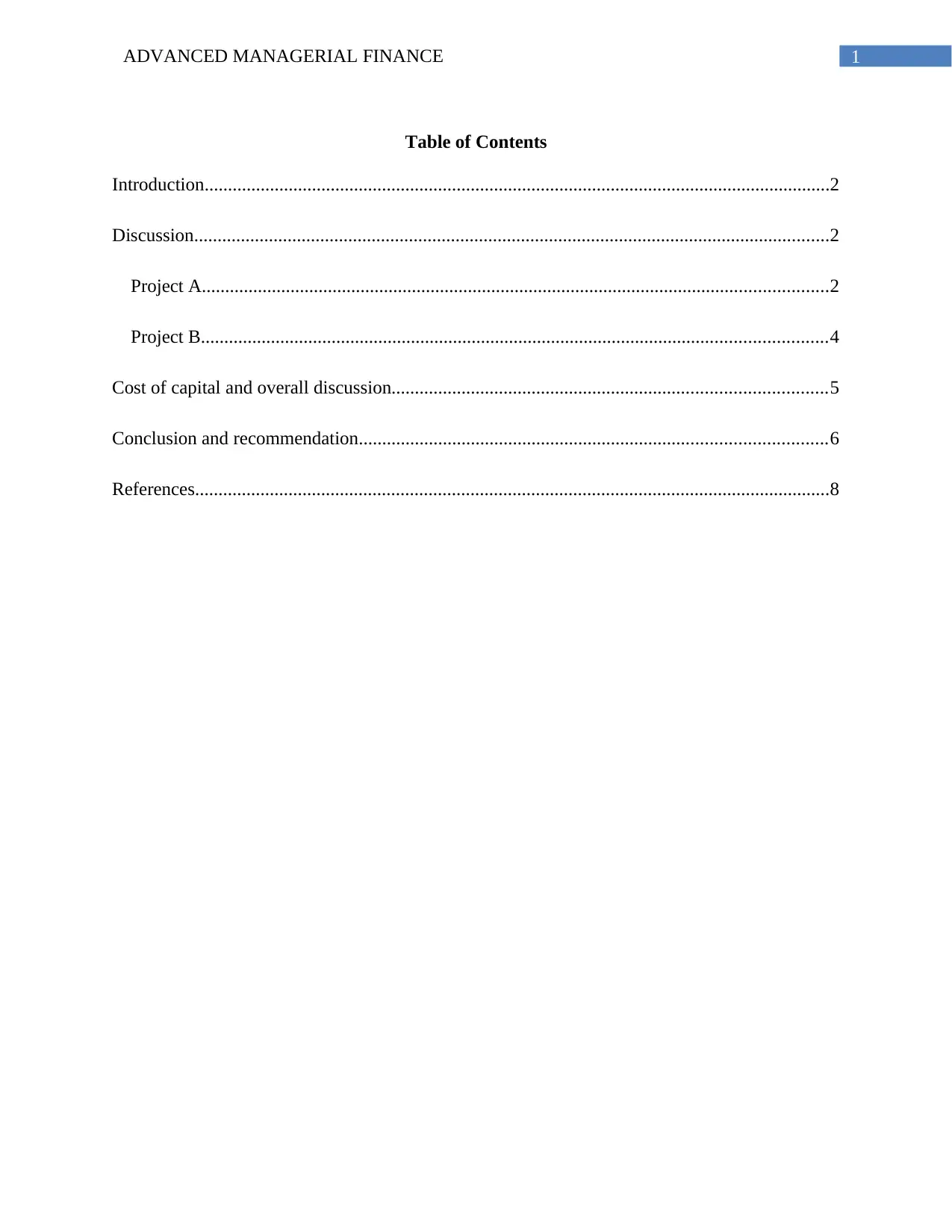
1ADVANCED MANAGERIAL FINANCE
Table of Contents
Introduction......................................................................................................................................2
Discussion........................................................................................................................................2
Project A......................................................................................................................................2
Project B......................................................................................................................................4
Cost of capital and overall discussion.............................................................................................5
Conclusion and recommendation....................................................................................................6
References........................................................................................................................................8
Table of Contents
Introduction......................................................................................................................................2
Discussion........................................................................................................................................2
Project A......................................................................................................................................2
Project B......................................................................................................................................4
Cost of capital and overall discussion.............................................................................................5
Conclusion and recommendation....................................................................................................6
References........................................................................................................................................8

2ADVANCED MANAGERIAL FINANCE
Introduction
Axis Corporation is planning for business expansion with investment in new projects
manufacturing new and advanced spares for motor vehicle. The company is having two potential
projects to be opted one is manufacturing of a new component to the emission control system of
cars and the other is the manufacturing of air conditioning adaptor for the Ford and GM
automobiles. In this report both the investment projects have been evaluated and analyzed with
the help capital budgeting and investment appraisal techniques to help in selecting the most
feasible investment option1.
Discussion
Product staff of the company have estimated the expected demand for the products and
revenue arising from them for the next three years. It has been further estimated that, cost of
goods sold would be 60% of the sales revenue. Therefore, before selecting an investment
proposal from the available projects, the profitability and feasibility of the projects must be
evaluated and analyzed. With the estimation of straight line depreciation, 30% tax rate and 14%
discounting rate, following investment appraisal techniques can be applied for evaluation of the
projects2.
Project A
Project A requires and initial investment of $120,000 with and expected life of 3 years.
With the expected sales revenue as estimated by the production staff, following analysis can be
made.
1 Alkaraan, Fadi. "Strategic investment decision-making perspectives." Advances in mergers and acquisitions 14
(2015): 53-66.
2 Nadkarni, G. A. "Investment appraisal in industrial undertakings." (2016).
Introduction
Axis Corporation is planning for business expansion with investment in new projects
manufacturing new and advanced spares for motor vehicle. The company is having two potential
projects to be opted one is manufacturing of a new component to the emission control system of
cars and the other is the manufacturing of air conditioning adaptor for the Ford and GM
automobiles. In this report both the investment projects have been evaluated and analyzed with
the help capital budgeting and investment appraisal techniques to help in selecting the most
feasible investment option1.
Discussion
Product staff of the company have estimated the expected demand for the products and
revenue arising from them for the next three years. It has been further estimated that, cost of
goods sold would be 60% of the sales revenue. Therefore, before selecting an investment
proposal from the available projects, the profitability and feasibility of the projects must be
evaluated and analyzed. With the estimation of straight line depreciation, 30% tax rate and 14%
discounting rate, following investment appraisal techniques can be applied for evaluation of the
projects2.
Project A
Project A requires and initial investment of $120,000 with and expected life of 3 years.
With the expected sales revenue as estimated by the production staff, following analysis can be
made.
1 Alkaraan, Fadi. "Strategic investment decision-making perspectives." Advances in mergers and acquisitions 14
(2015): 53-66.
2 Nadkarni, G. A. "Investment appraisal in industrial undertakings." (2016).
⊘ This is a preview!⊘
Do you want full access?
Subscribe today to unlock all pages.

Trusted by 1+ million students worldwide
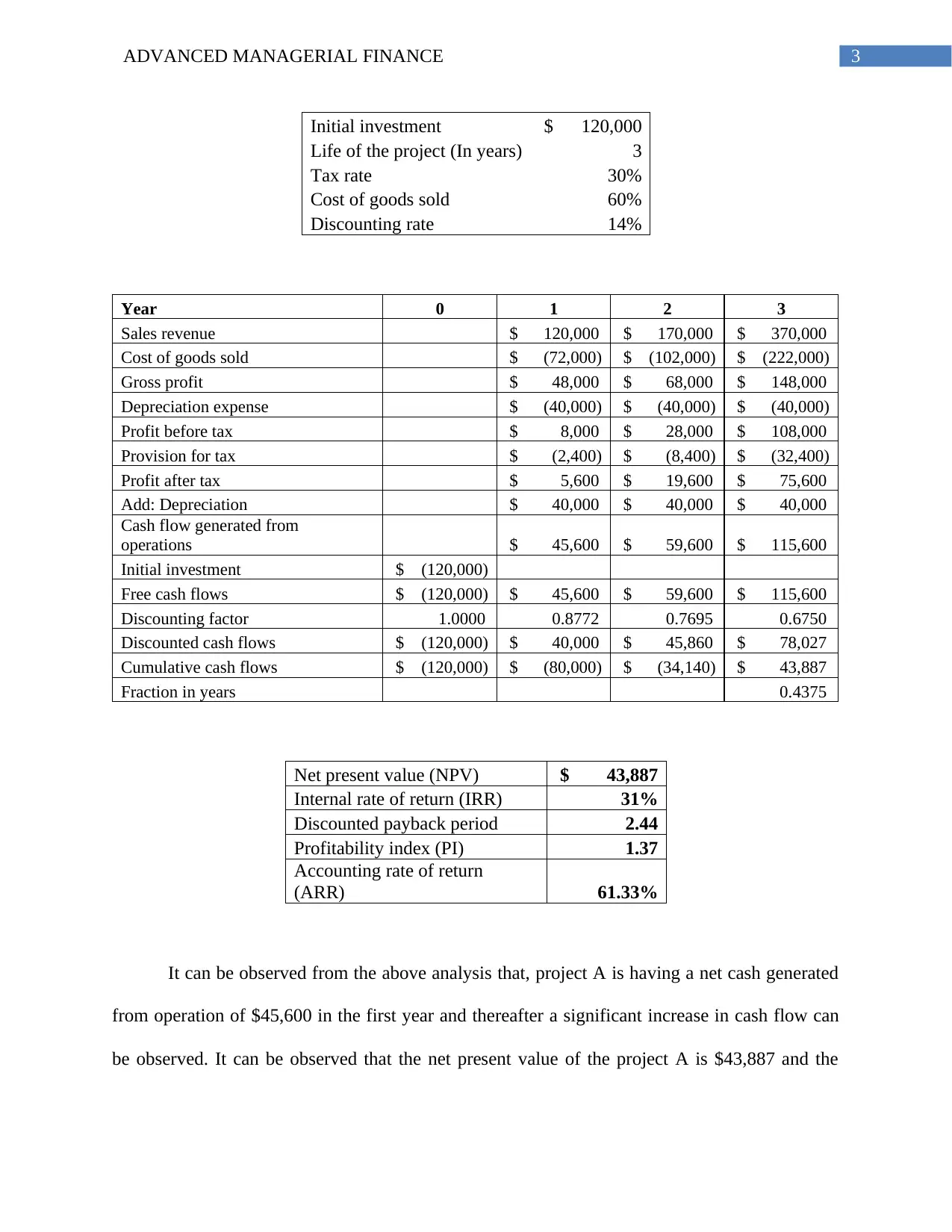
3ADVANCED MANAGERIAL FINANCE
Initial investment $ 120,000
Life of the project (In years) 3
Tax rate 30%
Cost of goods sold 60%
Discounting rate 14%
Year 0 1 2 3
Sales revenue $ 120,000 $ 170,000 $ 370,000
Cost of goods sold $ (72,000) $ (102,000) $ (222,000)
Gross profit $ 48,000 $ 68,000 $ 148,000
Depreciation expense $ (40,000) $ (40,000) $ (40,000)
Profit before tax $ 8,000 $ 28,000 $ 108,000
Provision for tax $ (2,400) $ (8,400) $ (32,400)
Profit after tax $ 5,600 $ 19,600 $ 75,600
Add: Depreciation $ 40,000 $ 40,000 $ 40,000
Cash flow generated from
operations $ 45,600 $ 59,600 $ 115,600
Initial investment $ (120,000)
Free cash flows $ (120,000) $ 45,600 $ 59,600 $ 115,600
Discounting factor 1.0000 0.8772 0.7695 0.6750
Discounted cash flows $ (120,000) $ 40,000 $ 45,860 $ 78,027
Cumulative cash flows $ (120,000) $ (80,000) $ (34,140) $ 43,887
Fraction in years 0.4375
Net present value (NPV) $ 43,887
Internal rate of return (IRR) 31%
Discounted payback period 2.44
Profitability index (PI) 1.37
Accounting rate of return
(ARR) 61.33%
It can be observed from the above analysis that, project A is having a net cash generated
from operation of $45,600 in the first year and thereafter a significant increase in cash flow can
be observed. It can be observed that the net present value of the project A is $43,887 and the
Initial investment $ 120,000
Life of the project (In years) 3
Tax rate 30%
Cost of goods sold 60%
Discounting rate 14%
Year 0 1 2 3
Sales revenue $ 120,000 $ 170,000 $ 370,000
Cost of goods sold $ (72,000) $ (102,000) $ (222,000)
Gross profit $ 48,000 $ 68,000 $ 148,000
Depreciation expense $ (40,000) $ (40,000) $ (40,000)
Profit before tax $ 8,000 $ 28,000 $ 108,000
Provision for tax $ (2,400) $ (8,400) $ (32,400)
Profit after tax $ 5,600 $ 19,600 $ 75,600
Add: Depreciation $ 40,000 $ 40,000 $ 40,000
Cash flow generated from
operations $ 45,600 $ 59,600 $ 115,600
Initial investment $ (120,000)
Free cash flows $ (120,000) $ 45,600 $ 59,600 $ 115,600
Discounting factor 1.0000 0.8772 0.7695 0.6750
Discounted cash flows $ (120,000) $ 40,000 $ 45,860 $ 78,027
Cumulative cash flows $ (120,000) $ (80,000) $ (34,140) $ 43,887
Fraction in years 0.4375
Net present value (NPV) $ 43,887
Internal rate of return (IRR) 31%
Discounted payback period 2.44
Profitability index (PI) 1.37
Accounting rate of return
(ARR) 61.33%
It can be observed from the above analysis that, project A is having a net cash generated
from operation of $45,600 in the first year and thereafter a significant increase in cash flow can
be observed. It can be observed that the net present value of the project A is $43,887 and the
Paraphrase This Document
Need a fresh take? Get an instant paraphrase of this document with our AI Paraphraser
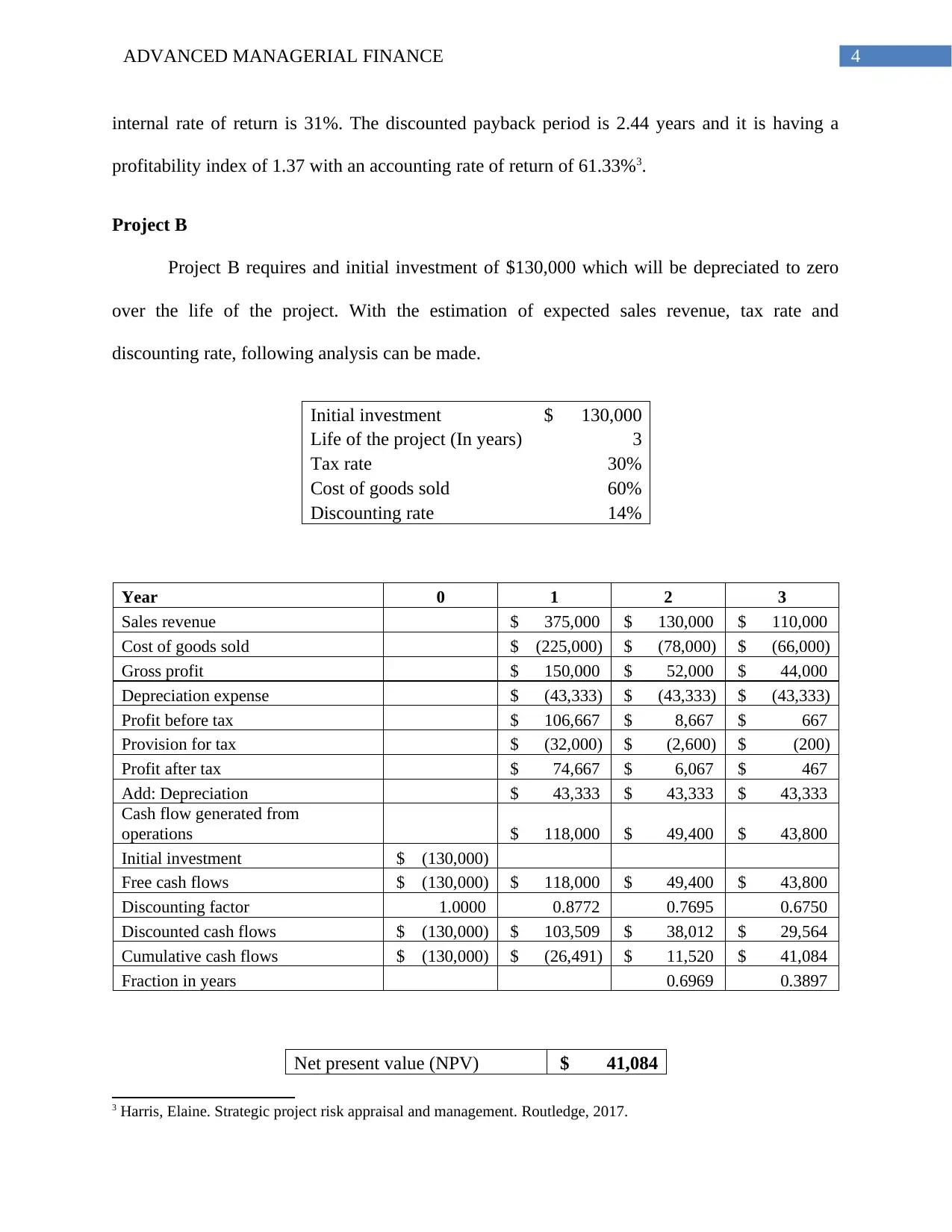
4ADVANCED MANAGERIAL FINANCE
internal rate of return is 31%. The discounted payback period is 2.44 years and it is having a
profitability index of 1.37 with an accounting rate of return of 61.33%3.
Project B
Project B requires and initial investment of $130,000 which will be depreciated to zero
over the life of the project. With the estimation of expected sales revenue, tax rate and
discounting rate, following analysis can be made.
Initial investment $ 130,000
Life of the project (In years) 3
Tax rate 30%
Cost of goods sold 60%
Discounting rate 14%
Year 0 1 2 3
Sales revenue $ 375,000 $ 130,000 $ 110,000
Cost of goods sold $ (225,000) $ (78,000) $ (66,000)
Gross profit $ 150,000 $ 52,000 $ 44,000
Depreciation expense $ (43,333) $ (43,333) $ (43,333)
Profit before tax $ 106,667 $ 8,667 $ 667
Provision for tax $ (32,000) $ (2,600) $ (200)
Profit after tax $ 74,667 $ 6,067 $ 467
Add: Depreciation $ 43,333 $ 43,333 $ 43,333
Cash flow generated from
operations $ 118,000 $ 49,400 $ 43,800
Initial investment $ (130,000)
Free cash flows $ (130,000) $ 118,000 $ 49,400 $ 43,800
Discounting factor 1.0000 0.8772 0.7695 0.6750
Discounted cash flows $ (130,000) $ 103,509 $ 38,012 $ 29,564
Cumulative cash flows $ (130,000) $ (26,491) $ 11,520 $ 41,084
Fraction in years 0.6969 0.3897
Net present value (NPV) $ 41,084
3 Harris, Elaine. Strategic project risk appraisal and management. Routledge, 2017.
internal rate of return is 31%. The discounted payback period is 2.44 years and it is having a
profitability index of 1.37 with an accounting rate of return of 61.33%3.
Project B
Project B requires and initial investment of $130,000 which will be depreciated to zero
over the life of the project. With the estimation of expected sales revenue, tax rate and
discounting rate, following analysis can be made.
Initial investment $ 130,000
Life of the project (In years) 3
Tax rate 30%
Cost of goods sold 60%
Discounting rate 14%
Year 0 1 2 3
Sales revenue $ 375,000 $ 130,000 $ 110,000
Cost of goods sold $ (225,000) $ (78,000) $ (66,000)
Gross profit $ 150,000 $ 52,000 $ 44,000
Depreciation expense $ (43,333) $ (43,333) $ (43,333)
Profit before tax $ 106,667 $ 8,667 $ 667
Provision for tax $ (32,000) $ (2,600) $ (200)
Profit after tax $ 74,667 $ 6,067 $ 467
Add: Depreciation $ 43,333 $ 43,333 $ 43,333
Cash flow generated from
operations $ 118,000 $ 49,400 $ 43,800
Initial investment $ (130,000)
Free cash flows $ (130,000) $ 118,000 $ 49,400 $ 43,800
Discounting factor 1.0000 0.8772 0.7695 0.6750
Discounted cash flows $ (130,000) $ 103,509 $ 38,012 $ 29,564
Cumulative cash flows $ (130,000) $ (26,491) $ 11,520 $ 41,084
Fraction in years 0.6969 0.3897
Net present value (NPV) $ 41,084
3 Harris, Elaine. Strategic project risk appraisal and management. Routledge, 2017.
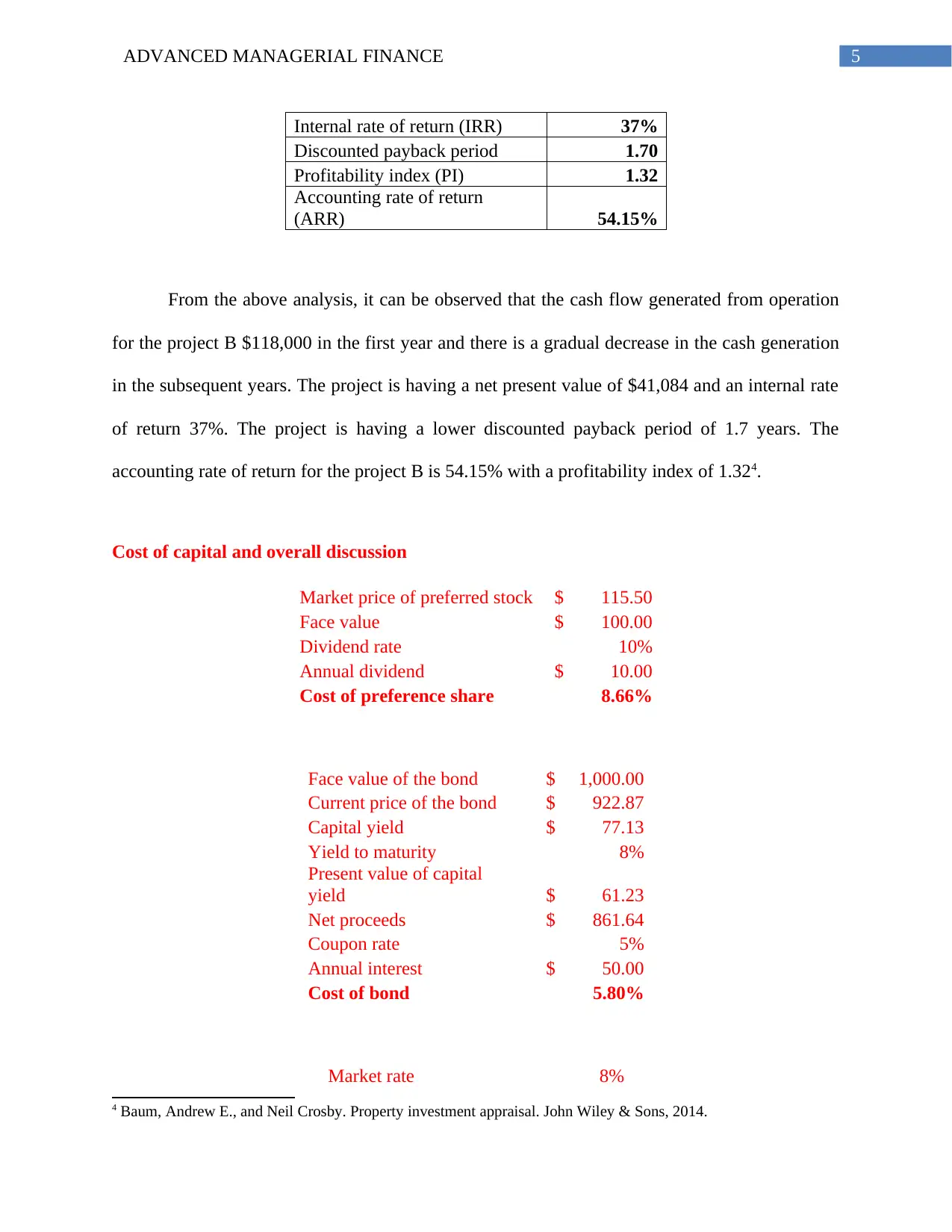
5ADVANCED MANAGERIAL FINANCE
Internal rate of return (IRR) 37%
Discounted payback period 1.70
Profitability index (PI) 1.32
Accounting rate of return
(ARR) 54.15%
From the above analysis, it can be observed that the cash flow generated from operation
for the project B $118,000 in the first year and there is a gradual decrease in the cash generation
in the subsequent years. The project is having a net present value of $41,084 and an internal rate
of return 37%. The project is having a lower discounted payback period of 1.7 years. The
accounting rate of return for the project B is 54.15% with a profitability index of 1.324.
Cost of capital and overall discussion
Market price of preferred stock $ 115.50
Face value $ 100.00
Dividend rate 10%
Annual dividend $ 10.00
Cost of preference share 8.66%
Face value of the bond $ 1,000.00
Current price of the bond $ 922.87
Capital yield $ 77.13
Yield to maturity 8%
Present value of capital
yield $ 61.23
Net proceeds $ 861.64
Coupon rate 5%
Annual interest $ 50.00
Cost of bond 5.80%
Market rate 8%
4 Baum, Andrew E., and Neil Crosby. Property investment appraisal. John Wiley & Sons, 2014.
Internal rate of return (IRR) 37%
Discounted payback period 1.70
Profitability index (PI) 1.32
Accounting rate of return
(ARR) 54.15%
From the above analysis, it can be observed that the cash flow generated from operation
for the project B $118,000 in the first year and there is a gradual decrease in the cash generation
in the subsequent years. The project is having a net present value of $41,084 and an internal rate
of return 37%. The project is having a lower discounted payback period of 1.7 years. The
accounting rate of return for the project B is 54.15% with a profitability index of 1.324.
Cost of capital and overall discussion
Market price of preferred stock $ 115.50
Face value $ 100.00
Dividend rate 10%
Annual dividend $ 10.00
Cost of preference share 8.66%
Face value of the bond $ 1,000.00
Current price of the bond $ 922.87
Capital yield $ 77.13
Yield to maturity 8%
Present value of capital
yield $ 61.23
Net proceeds $ 861.64
Coupon rate 5%
Annual interest $ 50.00
Cost of bond 5.80%
Market rate 8%
4 Baum, Andrew E., and Neil Crosby. Property investment appraisal. John Wiley & Sons, 2014.
⊘ This is a preview!⊘
Do you want full access?
Subscribe today to unlock all pages.

Trusted by 1+ million students worldwide
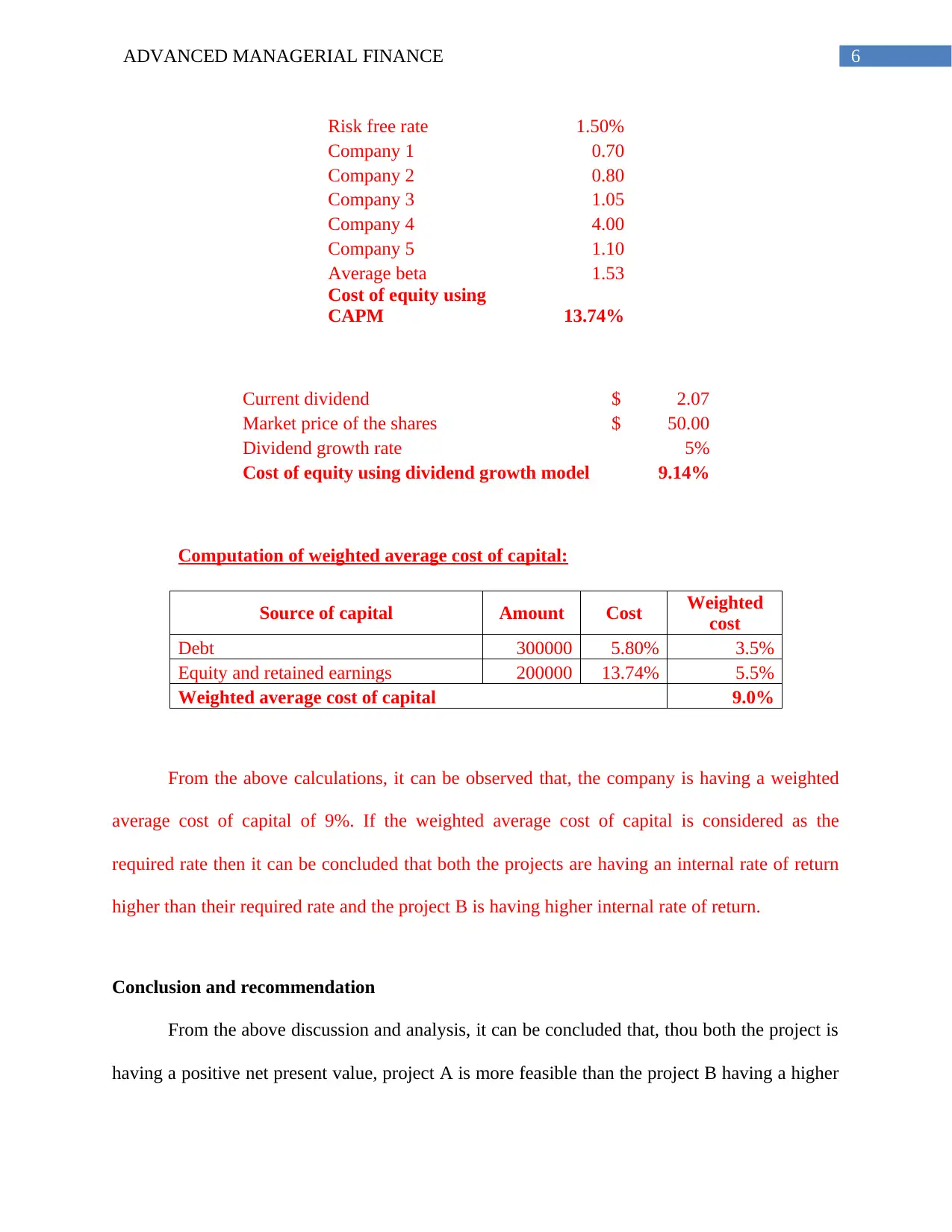
6ADVANCED MANAGERIAL FINANCE
Risk free rate 1.50%
Company 1 0.70
Company 2 0.80
Company 3 1.05
Company 4 4.00
Company 5 1.10
Average beta 1.53
Cost of equity using
CAPM 13.74%
Current dividend $ 2.07
Market price of the shares $ 50.00
Dividend growth rate 5%
Cost of equity using dividend growth model 9.14%
Computation of weighted average cost of capital:
Source of capital Amount Cost Weighted
cost
Debt 300000 5.80% 3.5%
Equity and retained earnings 200000 13.74% 5.5%
Weighted average cost of capital 9.0%
From the above calculations, it can be observed that, the company is having a weighted
average cost of capital of 9%. If the weighted average cost of capital is considered as the
required rate then it can be concluded that both the projects are having an internal rate of return
higher than their required rate and the project B is having higher internal rate of return.
Conclusion and recommendation
From the above discussion and analysis, it can be concluded that, thou both the project is
having a positive net present value, project A is more feasible than the project B having a higher
Risk free rate 1.50%
Company 1 0.70
Company 2 0.80
Company 3 1.05
Company 4 4.00
Company 5 1.10
Average beta 1.53
Cost of equity using
CAPM 13.74%
Current dividend $ 2.07
Market price of the shares $ 50.00
Dividend growth rate 5%
Cost of equity using dividend growth model 9.14%
Computation of weighted average cost of capital:
Source of capital Amount Cost Weighted
cost
Debt 300000 5.80% 3.5%
Equity and retained earnings 200000 13.74% 5.5%
Weighted average cost of capital 9.0%
From the above calculations, it can be observed that, the company is having a weighted
average cost of capital of 9%. If the weighted average cost of capital is considered as the
required rate then it can be concluded that both the projects are having an internal rate of return
higher than their required rate and the project B is having higher internal rate of return.
Conclusion and recommendation
From the above discussion and analysis, it can be concluded that, thou both the project is
having a positive net present value, project A is more feasible than the project B having a higher
Paraphrase This Document
Need a fresh take? Get an instant paraphrase of this document with our AI Paraphraser

7ADVANCED MANAGERIAL FINANCE
net present value. Though the internal rate of return is higher for the project B and the payback
period is also lower, the project A will cause more capital accumulation than the project B.
Hence, it can be recommended to select the project A for the investment.
net present value. Though the internal rate of return is higher for the project B and the payback
period is also lower, the project A will cause more capital accumulation than the project B.
Hence, it can be recommended to select the project A for the investment.
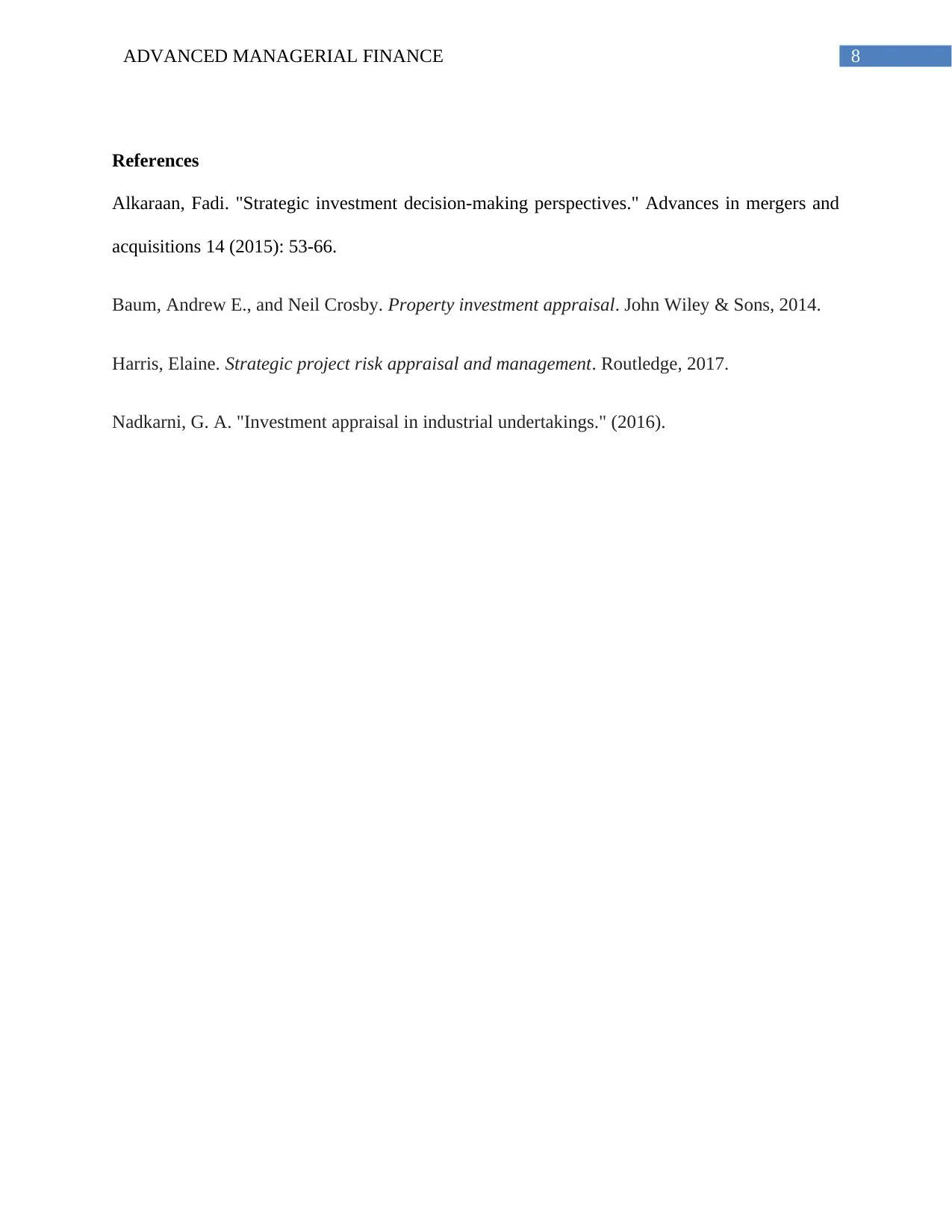
8ADVANCED MANAGERIAL FINANCE
References
Alkaraan, Fadi. "Strategic investment decision-making perspectives." Advances in mergers and
acquisitions 14 (2015): 53-66.
Baum, Andrew E., and Neil Crosby. Property investment appraisal. John Wiley & Sons, 2014.
Harris, Elaine. Strategic project risk appraisal and management. Routledge, 2017.
Nadkarni, G. A. "Investment appraisal in industrial undertakings." (2016).
References
Alkaraan, Fadi. "Strategic investment decision-making perspectives." Advances in mergers and
acquisitions 14 (2015): 53-66.
Baum, Andrew E., and Neil Crosby. Property investment appraisal. John Wiley & Sons, 2014.
Harris, Elaine. Strategic project risk appraisal and management. Routledge, 2017.
Nadkarni, G. A. "Investment appraisal in industrial undertakings." (2016).
⊘ This is a preview!⊘
Do you want full access?
Subscribe today to unlock all pages.

Trusted by 1+ million students worldwide
1 out of 9
Related Documents
Your All-in-One AI-Powered Toolkit for Academic Success.
+13062052269
info@desklib.com
Available 24*7 on WhatsApp / Email
![[object Object]](/_next/static/media/star-bottom.7253800d.svg)
Unlock your academic potential
Copyright © 2020–2025 A2Z Services. All Rights Reserved. Developed and managed by ZUCOL.





